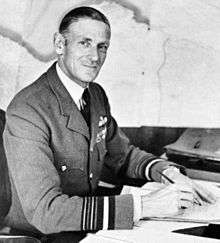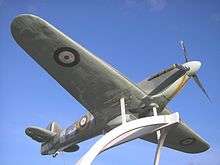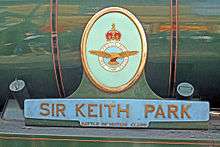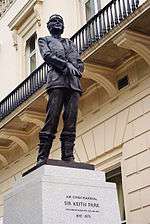Keith Park
| Sir Keith Rodney Park | |
|---|---|
 Sir Keith Park | |
| Nickname(s) |
"The Defender of London" "Skipper" |
| Born |
15 June 1892 Thames, New Zealand |
| Died |
6 February 1975 (aged 82) Auckland, New Zealand |
| Allegiance |
New Zealand United Kingdom |
| Service/branch |
New Zealand Army (1911–15) British Army (1915–18) Royal Air Force (1918–46) |
| Years of service | 1911–46 |
| Rank | Air Chief Marshal |
| Commands held |
Air Command South East Asia (1945–46) Middle East Command (1944–45) AHQ Malta (1942–44) AHQ Egypt (1942) No. 23 (Training) Group (1940–42) No. 11 (Fighter) Group (1940) RAF Tangmere (1937–38) RAF Northolt (1931–32) RAF Hornchurch (1928–29) No. 111 Squadron (1927–28) No. 48 Squadron (1918–19) |
| Battles/wars |
First World War Second World War |
| Awards |
Knight Grand Cross of the Order of the Bath Knight Commander of the Order of the British Empire Military Cross & Bar Distinguished Flying Cross Croix de guerre (France) Commander of the Legion of Merit (United States) |
| Other work | City Councillor, New Zealand |
Air Chief Marshal Sir Keith Rodney Park, GCB, KBE, MC & Bar, DFC (15 June 1892 – 6 February 1975) was a New Zealand soldier, First World War flying ace and Second World War Royal Air Force commander. He was in operational command during two of the most significant air battles in the European theatre in the Second World War, helping to win the Battle of Britain and the Battle of Malta. In Germany, he was supposedly known as "the Defender of London".[1]
Early life and army career
Park was born in Thames, New Zealand. He was the son of James Park from Scotland, geologist for a mining company and later a professor at the University of Otago in Dunedin.
An undistinguished young man, but keen on guns and riding, Keith Park was educated at King's College, Auckland until 1906[2] and then at Otago Boys' High School, Dunedin where he served in the cadets. Later he joined the Army as a Territorial soldier in the New Zealand Field Artillery.[3] In 1911, at age 19, he went to sea as a purser aboard collier and passenger steamships, earning the family nickname "skipper".
When the First World War broke out, Park left the ships and joined his artillery battalion.[3] As a non-commissioned officer, he participated in the landings at Gallipoli in April 1915, going ashore at Anzac Cove. In the trench warfare that followed, Park's achievements were recognised and in July 1915 he gained a commission as second lieutenant.[3] He commanded an artillery battalion during the August 1915 attack on Suvla Bay and endured more months of squalor in the trenches. At this time Park took the unusual decision to transfer from the New Zealand Army to the British Army, joining the Royal Horse and Field Artillery.[4]
Park was evacuated from Gallipoli in January 1916. The battle had left its mark on him both physically and mentally, though later on in life, he would remember it with nostalgia. He particularly admired the ANZAC commander, Sir William Birdwood, whose leadership style and attention to detail would be a model for Park in his later career.
After the hardship at Gallipoli, Park's battalion was shipped to France to take part in the Battle of the Somme. Here he learned the value of aerial reconnaissance, noting the manner in which German aircraft were able to spot Allied artillery for counter-fire and getting an early taste of flight by being taken aloft to check his battalion's camouflage. On 21 October 1916, Park was blown off his horse by a German shell. Wounded, he was evacuated to England and medically certified "unfit for active service," which technically meant he was unfit to ride a horse. After a brief remission recovering from his wounds, recuperating and doing training duties at Woolwich Depot, he joined the Royal Flying Corps (RFC) in December 1916.[3]
Flying career
First World War
In the RFC Park first learned to instruct and then learned to fly. After a spell as an instructor (March 1917 to the end of June) he was posted to France and managed a posting to join 48 Squadron,[3] at La Bellevue (near Arras), on 7 July 1917. Within a week the squadron moved to Frontier Aerodrome just east of Dunkirk. Park flew the new Bristol Fighter (a two-seat biplane fighter and reconnaissance aircraft) and soon achieved successes against German fighters, earning, on 17 August, the Military Cross for "conspicuous gallantry and devotion to duty", after shooting down an enemy aircraft and causing the destruction of three others[5] with Arthur Noss as his gunner.[6] He was promoted to temporary captain on 11 September.
After a break from flying. Park returned to France as a major to command 48 Squadron.[3] Here he showed his ability as a tough but fair commander, showing discipline, leadership and an understanding of the technical aspects of air warfare.
By the end of the war the strain of command had all but exhausted Park, but he had achieved much as a pilot and commander. He had earned a bar to his Military Cross,[7][8] the Distinguished Flying Cross[9] and the French Croix de Guerre. His final tally of aircraft claims was five destroyed and 14 (and one shared) "out of control". (His 13th "credit" of 5 September 1917 was Lieutenant Franz Pernet of Jasta Boelcke (a stepson of General Erich Ludendorff)).[10] He was also shot down twice during this period.
After the Armistice he married the London socialite Dorothy "Dol" Parish.
Inter-war years
After the War, Park was awarded a permanent commission as a captain in the Royal Air Force and when the new RAF officer ranks were introduced in 1919, Park became a flight lieutenant.[3] He served as a flight commander on No. 25 Squadron from 1919 to 1920 before taking up duties as a squadron commander at the School of Technical Training.[3] In 1922 he was selected to attend the newly formed RAF Staff College.[3] Later on, Park commanded RAF stations and was an instructor before promotion to Air Commodore and an appointment as Senior Air Staff Officer at Fighter Command under Air Chief Marshal Sir Hugh Dowding in 1938.[3]
Second World War


Battle of Britain
Promoted to the rank of air vice marshal,[11] Park took command of No. 11 Group RAF, responsible for the fighter defence of London and southeast England, in April 1940.[3] He organized fighter patrols over France during the Dunkirk evacuation and in the Battle of Britain his command took the brunt of the Luftwaffe's air attacks. Flying his personalised Hawker Hurricane around his fighter airfields during the battle, Park gained a reputation as a shrewd tactician with an astute grasp of strategic issues and as a popular "hands-on" commander. However, he became embroiled in an acrimonious dispute with ambitious Air Vice Marshal Trafford Leigh-Mallory, commander of 12 Group. Leigh-Mallory, already envious of Park for leading the key 11 Group while No. 12 Group was left to defend airfields, repeatedly failed to support No. 11 Group. Leigh-Mallory and his Big Wing (led by Douglas Bader) often ran amok through No. 11 Group airspace confusing the UK's defences. Quintin Brand's No. 10 Group in the South West successfully supported No. 11 Group when required despite having far more arduous defensive duties in its own area than No. 12 Group.
Park's subsequent objection to Leigh-Mallory's behaviour during the Big Wing controversy may have contributed to his and Dowding's removal from command at the end of the battle, but neither Park nor Dowding had much time for internal politics and fell easy prey to their waiting critics. Richard Saul of 13 Group on the other hand, wrote to Park on learning of his pending departure from No. 11 Group, commenting on "the magnificent achievements of your group in the past six months; they have borne the brunt of the war, and undoubtedly saved England".[12] Park was to remain indignant however over his and Dowding's treatment for the rest of his life. Park was posted immediately to Training Command before seeing later high ranking service in the Mediterranean and elsewhere, while Dowding was sent to America.
Park's No. 11 Group RAF were coordinated by fighter controllers in the No. 11 Group Operations Room in the underground bunker, now known as the Battle of Britain Bunker at RAF Uxbridge. Park himself was not based in the bunker but did visit to impart his wisdom at numerous key points during the battle, along with visits from the Royal Family and Winston Churchill. Among the many air battles fought over Britain, Park personally commanded RAF forces on several important dates; 13 August (Adlertag), 18 August (The Hardest Day) and the 15 September (Battle of Britain Day).
While overseeing the operations at RAF Uxbridge, Air Vice-Marshal Park stayed in a house opposite the entrance to the bunker. He used a small door to get from the house each day to the bunker. In 1996, the house, named Park House after the war in his honour, was demolished. Only the door and garden wall were retained.[13]
Later war career
_(Art.IWM_ART_LD_5921).jpg)
In January 1942 Park went to Egypt as Air Officer Commanding,[3] where he built up the air defence of the Nile Delta. In July 1942, following growing concern over the German and Italian attacks on Malta, he returned to action, commanding the vital air defence of the island.[3] From there his squadrons participated in the North African and Sicilian campaigns. In January 1944 he was made Air Officer Commanding-in-Chief Middle East Command.[3]
In June 1944, Park was considered by the Australian government to command the RAAF, because of rivalry between the nominal head, Chief of the Air Staff Air Vice Marshal George Jones and his deputy the operational head, Air Vice Marshal William Bostock, but General Douglas MacArthur said it was too late in the war to change. In February 1945 Park was appointed Allied Air Commander, South-East Asia, where he served until the end of the war.[3] Park was made a Commander of the American Legion of Merit in 1947.[14] On leaving the Royal Air Force, Park personally selected a Supermarine Spitfire to be donated to the Auckland War Memorial Museum, New Zealand. This aircraft is still on display today along with his service decorations and uniform.
Assessments
Park retired and was promoted to Air Chief Marshal on 20 December 1946 and returned to New Zealand, where he took up a number of civic roles and was elected to the Auckland City Council. He lived in New Zealand until his death on 6 February 1975, aged 82 years.
| “ | If any one man won the Battle of Britain, he did. I do not believe it is realised how much that one man, with his leadership, his calm judgement and his skill, did to save, not only this country, but the world. | ” |
| — Lord Tedder, Chief of the Air Staff, February 1947. | ||
While Sir Hugh Dowding controlled the Battle from day to day, it was Keith Park who controlled it hour by hour. Air Vice Marshal 'Johnnie' Johnson, one of the top Allied air aces of the war, said: "He was the only man who could have lost the war in a day or even an afternoon".[15] This was an echo of Winston Churchill's description of Admiral Jellicoe in the First World War.
Another ace who fought in the Battle of Britain, the RAF pilot Douglas Bader, said that “the awesome responsibility for this country’s survival rested squarely on Keith Park’s shoulders. British military history of this century has been enriched with the names of great fighting men from New Zealand, of all ranks and in every one of our services. Keith Park’s name is carved into history alongside those of his peers.”[15]
Although Park has not received widespread public recognition, either in Britain or his native New Zealand, he has a claim to be one of the greatest commanders in the history of aerial warfare.
Recognition

Keith Park Crescent, a residential road near the former RAF Biggin Hill, is named after Park, as is Keith Park Road within RAF Uxbridge.
A Southern Railway (Great Britain) West Country Class/Battle of Britain Class locomotive, no. 21C153 / 34053 was named after him in 1948. This locomotive carried Park's name and the RAF coat of arms on plates mounted either side of its boiler. The locomotive has survived into preservation, and has been restored from scrapyard condition. The locomotive is owned by Southern Locomotives Ltd and based on the Severn Valley Railway.
Park was portrayed by Trevor Howard in the 1969 film Battle of Britain.
Sir Keith Park is commemorated by the Sir Keith Park Memorial Airfield in Thames, New Zealand; and at the aviation section of the Museum of Transport and Technology, Auckland, New Zealand, the gate guardian of which is a replica of Park's Hawker Hurricane, OK1. The machine is not accurately painted, as it has a stripe around the rear of the fuselage in duck-egg green, which was not introduced until the spring of 1941, by which time he was commanding Training Command. The Sir Keith Park Special School in Mangere south Auckland bears his name. There is a Keith Park Crescent in Biggin Hill and a Keith Park Road in Hillingdon, London.

In 2008, London financier Terry Smith and others initiated an international campaign to erect a permanent statue of Park on the Fourth plinth in Trafalgar Square, in recognition of his work as commander of No. 11 Group during the Battle of Britain.[16][17][18] London Mayor Boris Johnson is on record as saying that devoting the plinth permanently to Park, while certainly worthy, might not be easy to facilitate.[19]
On 8 May 2009 Westminster City Council agreed to erect a 2.78 m (9 ft) statue in Waterloo Place.[20] A temporary 5 m (16.4 ft) statue was unveiled on the fourth plinth in Trafalgar Square on 4 November 2009. The fibre glass sculpture was in place for six months,[21][22] until it was temporarily moved to the Royal Air Force Museum in London in May 2010.[23] Finally, a permanent bronze version of the sculpture was installed at Waterloo Place and unveiled there in front of the Athenaeum Club on 15 September 2010, Battle of Britain Day, during the 70th anniversary commemorations of the Battle. Chief of the Air Staff, Air Chief Marshal Sir Stephen Dalton, said that Park was "a man without whom the history of the Battle of Britain could have been disastrously different. He was a man who never failed at any task he was given."[24]
Honours and decorations
- Knight Grand Cross of the Order of the Bath – 23 May 1946 (KCB – 1 January 1945, CB – 17 December 1940),
- Knight Commander of the Order of the British Empire – 27 November 1942
- Military Cross – 26 Sep 1917, Bar – 27 October 1917
- Distinguished Flying Cross – 3 June 1919
- Croix de guerre (France) – 18 April 1918
- Commander of the Legion of Merit – 27 June 1947
- MA (Oxford)
- Hon DCL – 1947
References
- Notes
- ↑ Benn, Tony and Lord Tebbit. "United in praise of the Defender of London." The Telegraph, 18 January 2009.
- ↑ "Park, Keith Rodney." Dictionary of New Zealand Biography. Retrieved: 8 September 2011.
- 1 2 3 4 5 6 7 8 9 10 11 12 13 14 15 "Air Chief Marshal Sir Keith Park." Air of Authority – A History of RAF Organisation. Retrieved: 8 September 2011.
- ↑ The London Gazette: (Supplement) no. 29308. p. 9514. 25 September 1915. Retrieved 1 November 2008.
- ↑ The London Gazette: (Supplement) no. 30466. p. 634. 9 January 1918. Retrieved 1 November 2008.
- ↑ Franks et al. 1997, p. 40.
- ↑ The London Gazette: (Supplement) no. 30355. p. 11108. 27 October 1917. Retrieved 1 November 2008.
- ↑ The London Gazette: (Supplement) no. 30583. p. 3418. 18 March 1918. Retrieved 1 November 2008.
- ↑ The London Gazette: (Supplement) no. 31378. p. 7032. 3 June 1919. Retrieved 1 November 2008.
- ↑ "Ludendorff." theaerodrome.com. Retrieved: 8 September 2011.
- ↑ The London Gazette: no. 34822. p. 1917. 2 April 1940. Retrieved 1 November 2008.
- ↑ Orange, p135 Sir Keith Park
- ↑ Skinner 2008, pp. 66—67.
- ↑ The London Gazette: (Supplement) no. 37998. p. 2940. 24 June 1947. Retrieved 21 September 2008.
- 1 2 "Introduction by Terry Smith, chairman of the Sir Keith Park Memorial Campaign" sirkeithpark.com. Retrieved: 8 September 2011.
- ↑ Smith, Terry. "The Sir Keith Park Memorial Campaign site." sirkeithpark.com. Retrieved: 17 June 2010.
- ↑ Harding, Thomas. "City boss calls for statue of war hero". The Daily Telegraph 26 February 2008. Retrieved: 16 August 2008.
- ↑ "They were the Few – but Sir Keith Park was a one-off." timesonline.co.uk, 24 January 2009. Retrieved; 16 June 2010.
- ↑ Kay, Martin. "Kiwi war hero in battle of the plinth." The Dominion Post, 31 May 2008. Retrieved: 16 August 2008.
- ↑ "Fourth Plinth RAF hero unveiled." BBC News, 4 November 2009. Retrieved: 16 June 2010.
- ↑ "Two statues will honour RAF hero." BBC News, 8 May 2009. Retrieved: 16 June 2010.
- ↑ Rennell, Tony. "A fitting place for a hero: The man who won the Battle of Britain, Sir Keith Park, stands proud on Trafalgar Square's fourth plinth." Daily Mail, 5 November 2009. Retrieved: 16 June 2010.
- ↑ "4th Plinth Statue Arrives At Museum." rafmuseum.org.uk, 12 May 2010. Retrieved: 16 June 2010.
- ↑ "Sir Keith Park bronze statue unveiled at Waterloo Place." BBC News, 15 September 2010.
- Bibliography
- Bungay, Stephen. The Most Dangerous Enemy: A History of the Battle of Britain. London: Aurum, 2001. ISBN 978-1-85410-801-2.
- Deighton, Len. Fighter: The True Story of the Battle of Britain. London: Jonathan Cape, 1977 (Originally published: London: Pimlico, 1996). ISBN 0-7126-7423-3.
- Franks, Norman; Russell Guest and Gregory Alegi. Above the War Fronts: The British Two-seater Bomber Pilot and Observer Aces, the British Two-seater Fighter Observer Aces, and the Belgian, Italian, Austro-Hungarian and Russian Fighter Aces, 1914–1918 (Volume 4 of Fighting Airmen of WWI Series) (Volume 4 of Air Aces of WWI). London: Grub Street, 1997. ISBN 978-1-898697-56-5.
- Hough, Richard. The Battle of Britain: The Greatest Air Battle of World War II. New York: W.W. Norton, 1989 (hardcover, ISBN 0-393-02766-X); 2005 (paperback, ISBN 0-393-30734-4).
- Orange, Vincent. Park: The Biography of Air Chief Marshal Sir Keith Park, GCB, KBE, MC, DFC, DCL. London: Grub Street, 2000. ISBN 1-902304-61-6.
External links
| Wikimedia Commons has media related to Keith Park. |
- Keith Rodney Park 2/1254 WWI NZEF Military Personnel Record (online)
- Keith Park at The Aerodrome
- Thames Coromandel District Council – our airfields
- Park, Keith Rodney 1892 – 1975, New Zealand Dictionary of Biography
- Opinion of "The New Zealand Edge"
- Air of Authority – A History of RAF Organisation – Air Chief Marshal Sir Keith Park
- Combat History of the Supermarine Spitfire – The Defence of Malta (1942)
- Profile on BBC News website.
- Clive James, BBC
- Joint Services Command and Staff College – Command and Leadership Series – Air Chief Marshal Sir Keith Rodney Park
- 1961 BBC Interview – Park describes Battle of Britain tactics, strategies and post-campaign conspiracies.
| Military offices | ||
|---|---|---|
| Preceded by C W Hill |
Station Commander RAF Tangmere 1937–1938 |
Succeeded by F Sowrey |
| Preceded by William Welsh |
Air Officer Commanding No. 11 Group April – December 1940 |
Succeeded by Trafford Leigh-Mallory |
| Preceded by Lawrence Pattinson |
Air Officer Commanding No. 23 (Training) Group 1940–1942 |
Succeeded by Douglas Harries |
| Preceded by Hugh Lloyd |
Air Officer Commanding AHQ Malta 1942–1944 |
Succeeded by Robert Foster |
| Preceded by Sir Sholto Douglas |
Commander-in-Chief Middle East Command 1944–1945 |
Succeeded by Sir Charles Medhurst |
| Preceded by Sir Guy Garrod |
Allied C-in-C Air Command South East Asia 1945–1946 |
Succeeded by Sir George Pirie |